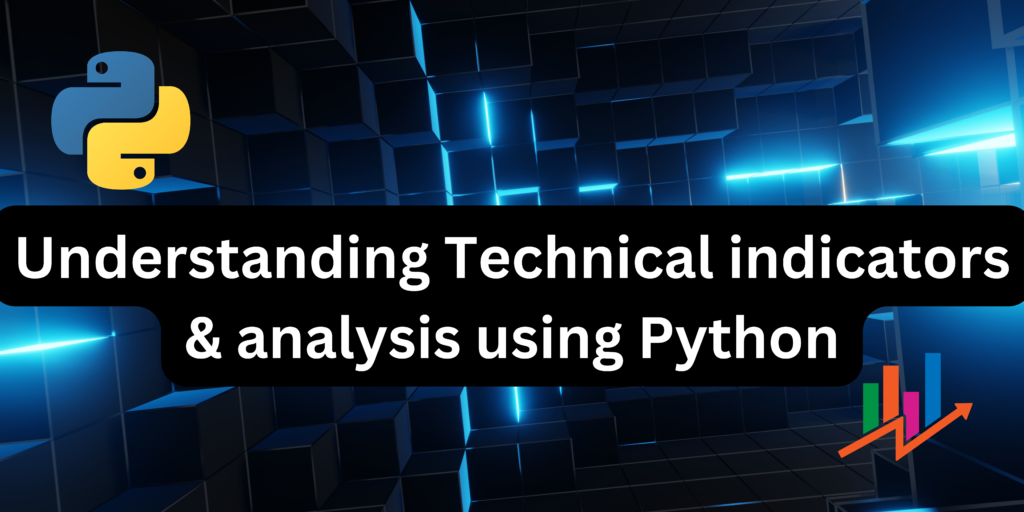This is a 5 article series that will brief everyone on what technical analysis and its indicators are and how to implement all these indicators in Python programming language and its powerful libraries.
In later articles, we will discuss four of the most widely used indicators: Moving Average Convergence and Divergence (MACD), Relative Strength Index (RSI), Moving Crossover Strategy, and Stochastic Oscillator. All these indicators predict the direction based on price action and momentum of the stock.
Technical Analysis Tutorials:
- Understanding Technical Analysis and Indicators using Python
- Moving Average Crossover Strategy: Python Implementation
- Relative Strength Index (RSI): A Powerful Trading Indicator Implemented in Python
- MACD Indicator: Python Implementation and Technical Analysis
- Bollinger Bands: Python Implementation
- Stochastic Indicator: Python Implementation
Technical analysis is a method used to find trading opportunities by analyzing historical price and volume data. It operates on three key assumptions: markets discount everything, prices move in trends, and history tends to repeat itself. Python’s powerful libraries can be leveraged to plot and visualize price data, enabling traders to identify trends and make informed decisions.
Recommended: Delivery Route Optimization using Python: A Step-by-Step Guide
Recommended: Flake8: Python’s Powerful Code Analysis Tool for Improved Code Quality
Introduction to Technical Analysis and Python
Essentially, we have two three schools of thought. One group is who applies Technical analysis, another group is a fan of Fundamental analysis and the third one are who follows a mixture of both. Let us consider an example.
Suppose you are a travel enthusiast and on your next vacation, you have 10 places that you can visit. One thing that you can do is visit the place with maximum footfall i.e. you visit places with the most tourist visits, which is Technical Analysis. The other thing you can do is research each place thoroughly and determine which place is the best to visit according to all your preferences which is Fundamental analysis.
Technical analysis is used to find trading opportunities and we use technical indicators to do that. Technical indicators provide us with buy or sell signals by following certain trends.
Key Assumptions in Technical Analysis
Now there are some assumptions in Technical Analysis. Let us have a look at that in the next segment.
Markets discount everything
This is one of the most fundamental assumptions. It tells us that everything is accounted for when it comes to the value of the stock price. For example, if too many securities are bought or sold by institutional investors, others assume that they have some extra information and they also do the same which affects the price of stock. Thus markets discount everything.
Price moves in trend
Price moves in a trend, for example, the price of an asset moves according to the momentum and weight i.e. prices keep going up until they get too heavy and fall. Similarly, prices keep falling until we see a reversal. The trick is to find out the right time of reversal. This can be only predicted accurately by God but educated approximations can be made using technical indicators.
History tends to repeat itself
After some time of practicing technical analysis, you will observe that history tends to repeat itself i.e., price movements happen in a very similar manner every time. Sometimes this trend similarity might take up to a year for example during Christmas, when assets react in the same way.
How Python is useful?
Python programming language with its tremendous power can be utilized for plotting and visualizing the prices. Let us look at the code for the same.
import numpy as np
import matplotlib.pyplot as plt
import datetime
# Generate random price data
np.random.seed(0)
num_prices = 100
start_date = datetime.datetime(2022, 1, 1)
dates = [start_date + datetime.timedelta(days=i) for i in range(num_prices)]
prices = np.random.normal(loc=100, scale=10, size=num_prices)
# Plot price data
plt.figure(figsize=(10, 5))
plt.plot(dates, prices, marker='o', linestyle='-', color='b')
plt.title('Price Trend')
plt.xlabel('Date')
plt.ylabel('Price')
plt.xticks(rotation=45)
plt.grid(True)
plt.tight_layout()
plt.show()
Let us look the the output of the code above. We have randomly generated data for 100 prices and plotted it to see any underlying trend.

Conclusion
This introductory article helped explore the fundamentals of technical analysis and its underlying assumptions. We saw how Python’s powerful libraries can be used to plot and visualize price data, facilitating trend analysis. In the upcoming articles, we will dive deeper into specific technical indicators such as MACD, RSI, Moving Crossover Strategy, and Stochastic Oscillator, and learn how to implement them using Python. Stay tuned to enhance your understanding of technical analysis and leverage Python’s capabilities in your trading strategies. Are you excited to uncover the insights hidden in price patterns?
Hope you enjoyed reading it!!
Recommended: Maximizing Cost Savings Through Offshore Development: A Comprehensive Guide
Recommended: Understanding Capital Asset Pricing Model (CAPM)
